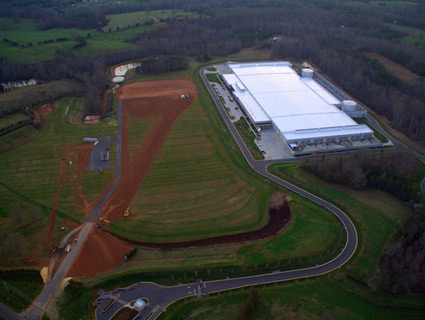
An Amazon Web Services data center in Stone Ridge, Virginia. Nathan Howard / Getty / Grist
This story was originally published by Grist and is reproduced here as part of the Climate Desk collaboration.
Earlier this year, the e-commerce corporation Amazon secured approval to open two new data centers in Santiago, Chile. The $400 million venture is the company’s first foray into locating its data facilities, which guzzle massive amounts of electricity and water in order to power cloud computing services and online programs, in Latin America—and in one of the most water-stressed countries in the world, where residents have protested against the industry’s expansion.
This week, the tech giant made a separate but related announcement. It plans to invest in water conservation along the Maipo River, which is the primary source of water for the Santiago region. Amazon will partner with a water technology startup to help farmers along the river install drip irrigation systems on 165 acres of farmland. The plan is poised to conserve enough water to supply around 300 homes per year, and it’s part of Amazon’s campaign to make its cloud computing operations “water positive” by 2030, meaning the company’s web services division will conserve or replenish more water than it uses up.
The reasoning behind this water initiative is clear: Data centers require large amounts of water to cool their servers, and Amazon plans to spend $100 billion to build more of them over the next decade as part of a big bet on its Amazon Web Services cloud-computing platform. Other tech companies such as Microsoft and Meta, which are also investing in data centers to sustain the artificial-intelligence boom, have made similar water pledges amid a growing controversy about the sector’s thirst for water and power.
One recent estimate found that ChatGPT requires an average-sized bottle of water for every 10 to 50 chat responses it provides.
Amazon claims that its data centers are already among the most water-efficient in the industry, and it plans to roll out more conservation projects to mitigate its thirst. However, just like corporate pledges to reach “net-zero” emissions, these water pledges are more complex than they seem at first glance.
While the company has indeed taken steps to cut water usage at its facilities, its calculations don’t account for the massive water needs of the power plants that keep the lights on at those very same facilities. Without a larger commitment to mitigating Amazon’s underlying stress on electricity grids, conservation efforts by the company and its fellow tech giants will only tackle part of the problem, according to experts who spoke to Grist.
The powerful servers in large data centers run hot as they process unprecedented amounts of information, and keeping them from overheating requires both water and electricity. Rather than try to keep these rooms cool with traditional air-conditioning units, many companies use water as a coolant, running it past the servers to chill them out. The centers also need huge amounts of electricity to run all their servers: They already account for around 3 percent of US power demand, a number that could more than double by 2030. On top of that, the coal, gas, and nuclear power plants that produce that electricity themselves consume even larger quantities of water to stay cool.
Will Hewes, who leads water sustainability for Amazon Web Services, told Grist that the company uses water in its data centers in order to save on energy-intensive air conditioning units, thus reducing its reliance on fossil fuels.
“Using water for cooling in most places really reduces the amount of energy that we use, and so it helps us meet other sustainability goals,” he said. “We could always decide to not use water for cooling, but we want to, a lot, because of those energy and efficiency benefits.”
In order to save on energy costs, the company’s data centers have to evaporate millions of gallons of water per year. It’s hard to say for sure how much water the data center industry consumes, but the ballpark estimates are substantial. One 2021 study found that US data centers consumed around 415,000 acre-feet of water in 2018, even before the artificial-intelligence boom. That’s enough to supply around a million average homes annually, or about as much as California’s Imperial Valley takes from the Colorado River each year to grow winter vegetables. Another study found that data centers operated by Microsoft, Google, and Meta withdrew twice as much water from rivers and aquifers as the entire country of Denmark.
In Pennsylvania, one Amazon data center consumes about 20 percent of the electricity capacity of the nuclear power plant nearby.
It’s almost certain that this number has ballooned even higher in recent years as companies have built more centers to keep up with the artificial-intelligence boom, since AI programs such as ChatGPT require massive amounts of server real estate. Tech companies have built hundreds of new data centers in the last few years alone, and they are planning hundreds more. One recent estimate found that ChatGPT requires an average-sized bottle of water for every 10 to 50 chat responses it provides. The on-site water consumption at any one of these companies’ data centers could now rival that of a major beverage company such as PepsiCo.
Amazon doesn’t provide statistics on its absolute water consumption; Hewes told Grist the company is “focused on efficiency.” However, the tech giant’s water usage is likely lower than some of its competitors—in part because the company has built most of its data centers with so-called evaporative cooling systems, which require far less water than other cooling technologies and only turn on when temperatures get too high. The company pegs its water usage at around 10 percent of the industry average, and in temperate locations such as Sweden, it doesn’t use any water to cool down data centers except during peak summer temperatures.
Companies can reduce the environmental impact of their AI business by building them in temperate regions that have plenty of water, but they must balance those efficiency concerns with concerns about land and electricity costs, as well as the need to be close to major customers. Recent studies have found that data center water consumption in the US is “skewed toward water stressed subbasins” in places like the Southwest, but Amazon has clustered much of its business farther east, especially in Virginia, which boasts cheap power and financial incentives for tech firms.
“A lot of the locations are driven by customer needs, but also by [prices for] real estate and power,” said Hewes. “Some big portions of our data center footprint are in places that aren’t super hot, that aren’t in super water stressed regions. Virginia, Ohio—they get hot in the summer, but then there are big chunks of the year where we don’t need to use water for cooling.” Even so, the company’s expansion in Virginia is already causing concerns over water availability.
To mitigate its impacts in such basins, the company also funds dozens of conservation and recharge projects like the one in Chile. It donates recycled water from its data centers to farmers, who use it to irrigate their crops, and it has also helped restore the rivers that supply water-stressed cities such as Cape Town, South Africa; in northern Virginia, it has worked to install cover crop farmland that can reduce runoff pollution in local waterways.
The company treats these projects the way other companies treat carbon offsets, counting each gallon recharged against a gallon it consumes at its data centers. Amazon said in its most recent sustainability report that it is 41 percent of the way to meeting its goal of being “water positive.” In other words, it has funded projects that recharge or conserve a little over 4 gallons of water for every 10 gallons of water it uses.
But despite all this, the company’s water stewardship goal doesn’t include the water consumed by the power plants that supply its data centers. This consumption can be as much as three to 10 times as large as the on-site water consumption at a data center, according to Shaolei Ren, a professor of engineering at the University of California, Riverside, who studies data center water usage. As an example, Ren pointed to an Amazon data center in Pennsylvania that relies on a nuclear power plant less than a mile away. That data center uses around 20 percent of the power plant’s capacity.
“If they are able to capture some of the growing water and clean it and return to the community, that’s better than nothing.”
“They say they’re using very little water, but there’s a big water evaporation happening just nearby, and that’s for powering their data center,” he said.
Companies like Amazon can reduce this secondary water usage by relying on renewable energy sources, which don’t require anywhere near as much water as traditional power plants. Hewes says the company has been trying to “manage down” both water and energy needs through a separate goal of operating on 100 percent renewable energy, but Ren points out that the company’s data centers need round-the-clock power, which means intermittently available renewables like solar and wind farms can only go so far.
Amazon isn’t the only company dealing with this problem. CyrusOne, another major data center firm, revealed in its sustainability report earlier this year that it used more than eight times as much water to source power as it did on-site at its data centers. “As long as we are reliant on grid electricity that includes thermoelectric sources to power our facilities, we are indirectly responsible for the consumption of large amounts of water in the production of that electricity,” the report said.
As for replenishment projects like the one in Chile, they too will only go part of the way toward reducing the impact of the data center explosion. Even if Amazon’s cloud operations are “water positive” on a global scale, with projects in many of the same basins where it owns data centers, that doesn’t mean it won’t still compromise water access in specific watersheds. The company’s data centers and their power plants may still withdraw more water than the company replenishes in a given area, and replenishment projects in other aquifers around the world won’t address the physical consequences of that specific overdraft.
“If they are able to capture some of the growing water and clean it and return to the community, that’s better than nothing, but I think it’s not really reducing the actual consumption,” Ren said. “It masks out a lot of real problems, because water is a really regional issue.”















